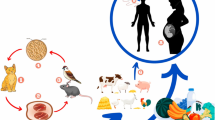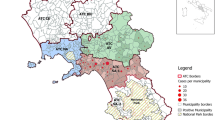Summary
Two indigenous Cameroonian taurine cattle breeds (Namchi and Kapsiki) were evaluated for trypanosusceptibility following inoculation withTrypanosoma congolense. The degree of zebu ancestry in the experimental animals was assessed using 6 microsatellite markers which are known to have certain unique alleles which are diagnostic ofBos indicus genetic input. Their response to the infection was compared to that of known trypanotolerant (N’Dama) and trypanosusceptible (Ngaoundere Gudali) cattle. The Namchi and the N’Dama controlled the development and severity of anaemia and parasitaemia better than the Kapsiki and the Gudali. For these parameters, there was no significant difference between the N’Dama and Namchi nor between the Kapsiki and Gudali. Similarly, weight loss showed significant breed variation. The N’Dama lost the least weight and the Kapsiki the most. Zebu introgression in the Namchi was comparable to that in the N’Dama while that of the Kapsiki breed was higher, indicating a high level of cross breeding. From the results, the Namchi are considered trypanotolerant while the Kapsiki are trypanosusceptible. The potential exploitation of the indigenous Namchi cattle is discussed.
Résumé
La suceptibilité aux trypanosomes fut évaluée chez 2 races indigènes de bétail camerounais (Namchi et Kapsiki) après infection avecTrypanosoma congolense. Six microsondes furent utilisées chez les animaux pour connaître leur filiation avec la race zebu, ces sondes étant connues comme présentant des allèles particuliers permettant de suivre l’apport genétique dû àBos indicus. Leur réaction à l’infection fut comparée à celle observée chez une race resistante (N’Dama) et une race susceptible (Ngaoundéré Gudali). Le développement et la sévérité des anèmies et des parasites furent mieux controlés chez les races Namchi et N’Dama que chez les races Kapsiki et Gudali. Pour ces paramètres il ne fut pas observé de différence significative entre les races appartenant au même groupe. De même, la perte en poids fut liée à la race étudiée. La race N’Dama montra la plus faible perte de poids et la race Kapsiki, la plus importante.
Les races Namchi et N’Dama montrèrent des niveaux de croisement identique, la race Kapsiki étant la plus génétiquement modifiée. D’après ces résultats la race Namchi est considérée comme résistante aux trypanosomes alors que la race Kapsiki est susceptible aux infections par trypanosomes. Les utilisations potentielles de la race indigène sont discutées.
Resumen
Dos razas de ganado vacuno de Camerún pertenecientes al tronco europeo (Namchi y Kapsiki) fueron evaluadas para determinar su tripanosusceptibilidad tras ser inoculadas conTrypanosoma congolense. El porcentaje de sangre cebú en los animales experimentales se evaluó mediante microsatélites que contienen alelos específicos deBos indicus. La respuesta de los animales a la infestación se comparó con la de animales tripanotolerantes (N’Dama) y tripanosusceptibles (Ngaoundere Gudali). Los animales de raza Namchi y N’Dama controlaron el desarrollo y severidad de la anemia y de la parasitemia mejor que los animales de raza Kapsiki y Gudali. En relación a estos parámetros no hubo diferencias significativas entre las razas N’Dama y Namchi por una parte ni tampoco entre las razas Kapsiki y Gudali por otra. Igualmente, la pérdida de peso mostró un efecto significativo de la raza. Los animales de raza N’Dama fueron los que perdieron menos peso, mientras que los animales de raza Kapsiki fueron los que perdieron más peso. El porcentaje de sangre cebú en las razas Namchi y N’Dama fue similar, mientras que el de la raza Kapsiki fue superior, indicando un alto nivel de cruzamiento. A partir de los resultados obtenidos, puede concluirse que la raza Namchi es tripantotolerante y la raza Kapsiki es tripanosusceptible.
Similar content being viewed by others
References
Bradley, D. G., MacHugh, D. E., Loftus, R. T., Sow, R. S., Hoste, C. H. &Cunningham, E. P. (1994). Zebutaurine variation in Y-chromosomal DNA: a sensitive assay for genetic introgression in West African trypanotolerant cattle populations.Animal Genetics,25, 7–12.
Cuisance, D. (1991). Lutte contre les glossines dans ‘Adamaoua, Cameroon. Bilan de situation et recommandation. Rapport Banque Mondiale, pp 53.
Dineur, B. &Thys E. (1986). Les Kapsiki: race taurine de l’extreme nord Camerounais. I. Introduction et barymetrie.Revue d’Elevage et de Médecine Vétérinaire des Pays Tropicaux,39, 435–442.
Eggen, A., Solinas Tolda, S., Dietz, A. B., Womack, J. E., Stranzinger, G. &Fries, R. (1992). RASA contains a polymorphic microsatellite and maps to bovine syntenic group U22 on chromsome 7q24-qter.Mammalian Genome,3, 559–563.
FAO (1992). The management of global animal genetic resources. Proc. FAO Expert Consultation. FAO Animal Production and Health Paper No. 104, Rome.
Fries, R., Eggen, A. &Womack, J. E. (1993). The bovine genome map.Mammalian Genome,4, 405–428.
Herbert, W. J. &Lumsden, W. H. R. (1976).Trypanosoma brucei: a rapid matching method for estimating the host’s parasitaemia.Experimental Parasitology,49, 427–431.
ILCA (1979).Trypanotolerant Livestock in West and Central Africa. Vol. 2: Country studies. International Livestock Centre for Africa (ILCA) Monograph No. 2, Addis Ababa, Ethiopia, pp 303.
ILCA (1992).Trypanotolerant Livestock in West and Central Africa. Vol. 3: A decade’s results. International Livestock Centre for Africa (ILCA), Monograph No. 2, Addis Ababa, Ethiopia, pp 206.
Kemp, S. J., Hishida, O., Wambugu, J., Rink, A., Longeri, M. L., Ma, R. Z., Da, Y., Lewin, H. A., Barendse, W. &Teale, A. J. (1995). A panel of polymorphic bovine, ovine and caprine microsatellite markers.Animal Genetics,26, 299–306.
MacHugh, D. E. (1995). PhD thesis, University of Dublin, Ireland.
Moore, S. S. &Byrne, K. (1993). Dinucleotide polymorphism at the bovine histamine H1 receptor locus.Animal Genetics,24, 72.
Murray, M., Murray, P. K. &McIntyre, W. L. M. (1977). An improved parasitological technique for the diagnosis of African trypanosomiasis.Transactions of the Royal Society of Tropical Medicine and Hygiene,71, 325–326.
Murray, M., Stear, M. J., Trail, J. C. M., d’Ieteren, G. D. M., Agyemang, K. & Dwinger, R. H. (1991). Trypanosomiasis in cattle: prospects for control. In:Breeding for Disease Resistance in Farm Animals. (Eds J. B. Owen and R. F. C. Axford). CAB International, pp 203–234.
Paling, R. W. &Dwinger, R. H. (1993). Potential of trypanotolerance as a contribution to sustainable livestock production in tsetse affected Africa.Veterinary Quarterly,15, 60–67.
Rege, J. E. O., Aboagye, G. S. &Tawah, C. L. (1994). Shorthorn cattle of West and Central Africa. 1. Origin, distribution, classification and population statistics.World Animal Review,78, 2–13.
Roberts, C. J. &Gray, A. R. (1973). Studies on trypanosome-resistant cattle. The breeding and growth performance of N’Dama, Muturu and zebu cattle maintained under the same conditions of husbandry.Tropical Animal Health and Production,5, 220–233.
Woo, P. T. K. (1971). Evaluation of the haematocrit centrifuge and other techniques for field diagnosis of human trypanosomiasis and filariasis.Acta Tropica,28, 298–303.
Author information
Authors and Affiliations
Rights and permissions
About this article
Cite this article
Achukwi, M.D., Tanya, V.N., Hill, E.W. et al. Susceptibility of the namchi and kapsiki cattle of cameroon to trypanosome infection. Trop Anim Health Prod 29, 219–226 (1997). https://doi.org/10.1007/BF02632308
Accepted:
Issue Date:
DOI: https://doi.org/10.1007/BF02632308




